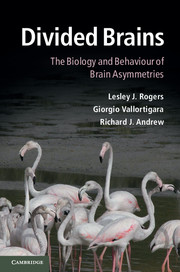6 - Applications and future directions
Published online by Cambridge University Press: 05 February 2013
Summary
Summary
This chapter considers potential applications of our knowledge about brain lateralization and some of the important questions for future research. First, it covers the potential to improve animal welfare by measuring lateralized behaviour. In doing so, it highlights the role of the right hemisphere in the expression of intense emotions and stress responses and extends this to consider unusual lateralization in humans. Then it outlines some of the areas important for future investigation of lateralization in animals and humans. The latter includes understanding of personality theory, thought processes, and formation and recall of memory. Lateralization in the different sensory systems and the interactions between the hemispheres in natural as well as laboratory contexts are important topics for further investigation.
Application of knowledge of lateralization
Now that lateralization has been established as a general characteristic of the vertebrate brain, it is worthwhile considering how this knowledge might be applied usefully to understanding animal behaviour and what lines of research are likely to be fruitful in the future.
Animal welfare
Can knowledge of lateral preferences be usefully applied to improving the welfare of animals? It seems very possible that continuous or exaggerated dependence on the right hemisphere occurs in animals suffering stress and that we might determine which animals are in this condition or which environments induce it by measuring eye, ear or nostril preferences. Although some studies have touched on this question, few have investigated it in any detail.
- Type
- Chapter
- Information
- Divided BrainsThe Biology and Behaviour of Brain Asymmetries, pp. 153 - 171Publisher: Cambridge University PressPrint publication year: 2013



